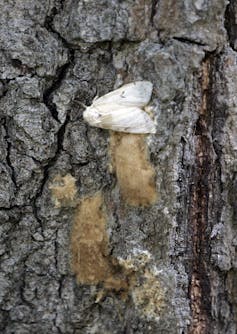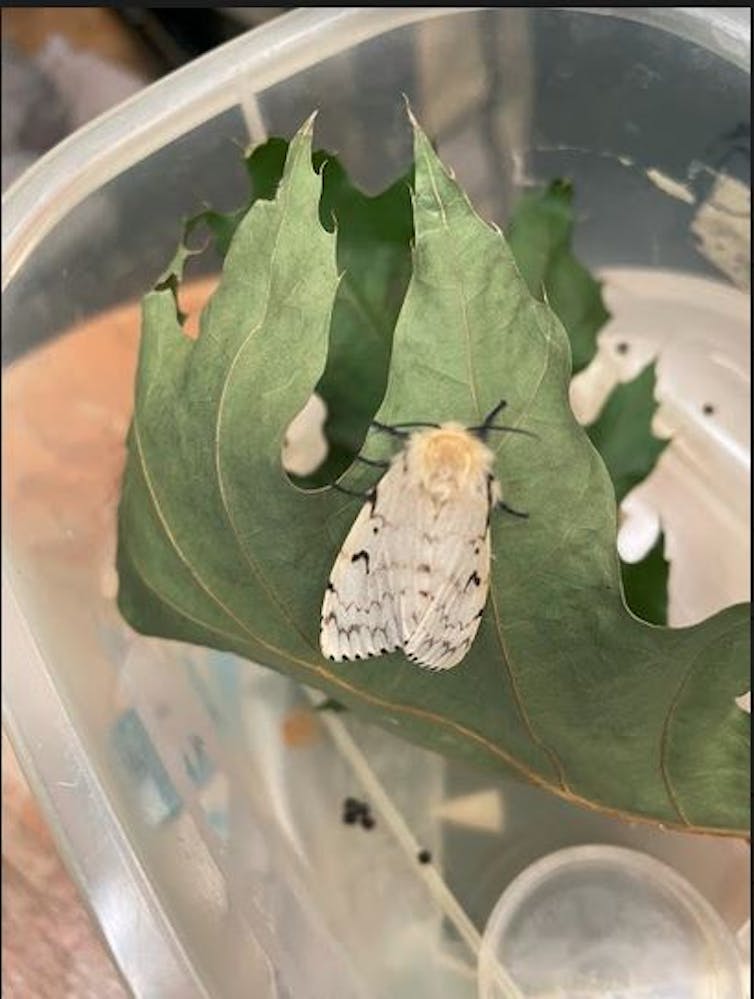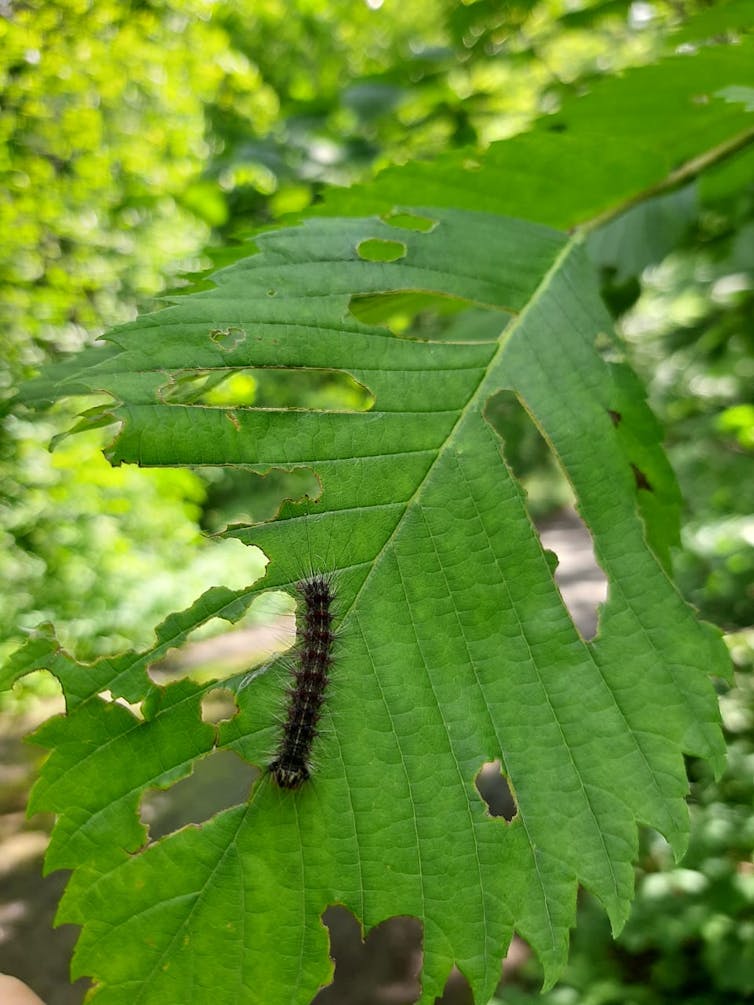Science
Why the spongy moth outbreak has vanished in Québec – The Conversation

Last year, forests across southern Québec and Ontario and much of New England turned eerily leafless. The air hummed with the sound of munching mandibles and tree trunks were covered with a writhing carpet of caterpillars, while showers of caterpillar poop fell softly on the heads of unsuspecting hikers and campers.
The population of the European spongy moth, which had been gradually increasing since 2019, reached a dramatic peak in 2021 and completely vanished this year.
In 2020, the hungry caterpillar damaged 583,157 hectares of forests in Ontario and this number is bound to go up when the 2021 numbers are revealed.
Insect outbreaks are one of the most important natural disturbances in Canadian forests. As a biologist who has been working on plant-insect interactions for over 20 years, I see that the frequency, intensity and range of insect outbreaks keeps changing. To protect trees in our forests and cities, we need tree diversity.
Insect outbreaks
An insect outbreak can be frightening. In deserts around the world, vast swarms of locusts can blot out the sun for hours as they fly overhead. In the Rocky Mountains, hillsides are covered with dead trees, killed by the inner-bark-eating mountain pine beetle.
THE CANADIAN PRESS/Paul Chiasson
However, insect outbreaks are not a new phenomenon. Chinese historical records document locust outbreaks for almost 2,000 years, while paleo-ecological studies show that Québec’s boreal forests have witnessed spruce budworm outbreaks for at least 8,000 years.
Such insect outbreaks are part of how temperate and boreal forests — as well as semi-arid grasslands and deserts — function. Insect outbreaks stimulate nutrient cycling, accelerate forest succession and can renew forests.

(AP Photo/Bob Child, File)
Female insects can produce hundreds of offspring and for the population to remain stable, only two of these need to survive. A small increase in survival, due to factors like favorable weather conditions, can lead to a population explosion and an outbreak.
In the case of the mountain pine beetle and the desert locust, warming temperatures, increased cyclone activity and other such effects of climate change are bringing these favorable conditions more frequently to new areas, thus dramatically increasing the extent of outbreaks.
However, these outbreaks always come to an end because of what ecologists call lagged-density dependent population dynamics. Here, density-dependent means that the insects’ mortality rate depends on the density of its population. As the population increases, mortality also increases and survival rate decreases. Meanwhile, lagged means there is a delay in this process — the insect mortality increases more slowly than population growth, causing an outbreak.
The outbreak crashes when the insect mortality eventually catches up with its population size. This usually happens due to a combination of factors including low food supply and increase in predators, parasitoids — insects that lay their eggs inside other insects — and diseases.
Where did the spongy moth go?
Students in my laboratory have been rearing spongy moth caterpillars for the past three years and have found that the mortality of these caterpillars gradually increased as the population grew.
In 2019, one student, Pamela Yataco Marquez reared over 300 caterpillars and observed an 80 per cent survival rate. However, this year, despite an extensive search, Marie-Eve Jarry, Geovana Demarchi and Victoria Yip were able to find and rear only 97 caterpillars and only six survived to adult.

(Victoria Yip), Author provided
Several mortality agents including a virus Lymantria dispar multiple nucleopolyhedrovirus, the fungal disease Entomophaga maimaiga and two tiny parasitoid wasps called Cotesia melanoscela and Ooencyrtus kuvanae finally caught up with the insect population.
When parasitoids eggs — laid inside either the eggs or the bodies of other insects — hatch, they devour their host from the inside and eventually emerge from the dead host, ready to start the life-cycle anew.
They are more like predators than parasites because they kill their host, and are efficient biocontrol agents that decrease pest insect populations.
Creeping across borders
While the spongy moth is native to Europe, it has been in eastern North America since the 1860s and is part of our fauna now.
It has not reached the western part of the continent yet and the best way to stop this is to inspect outdoor gear for caterpillars or egg masses before travelling and not to move firewood.
The Asian spongy moth population has not spread in North America yet, and entomologists are working hard to keep it out.

(Geovana Demarchi), Author provided
In the past 150 years, many of the European spongy moth’s natural enemies, including the fungal disease mentioned above and several parasitoids, have also been introduced, either inadvertently or deliberately. Our findings show that these natural enemies are well established in our region and have been effective in collapsing the outbreak.
The current range of the spongy moth distribution in North America extends up to southern Canada. Here, the eggs that spend the winter on tree trunks suffer high mortality due to cold, knocking down the survival rate irrespective of population size.
Forest managers in Québec and Ontario are on the alert for increases in spongy moth outbreaks — including both more severe and longer duration outbreaks similar to those seen in the U.S. — and a possible northward shift of the distribution range.
Diverse forests
While a tree that is leafless in July may appear dead, many trees can survive a few years of defoliation, drawing on stored reserves to flush out new leaves.
The spongy moth outbreak in the Montréal area in the late 1970s slowed tree growth, but did not cause the widespread death of forest trees. However, tree mortality does occur further south in the U.S. and depends on the diversity of trees in the forest area. The death of tree species preferred by the caterpillar is lower in diverse forests that mix in less-vulnerable species.
Diverse forests are more resilient under various stresses than more homogeneous ones. We need to create and preserve such diverse forests to help prepare for new types of insect outbreaks in our changing world.
Science
Marine plankton could act as alert in mass extinction event: UVic researcher – Saanich News


A University of Victoria micropaleontologist found that marine plankton may act as an early alert system before a mass extinction occurs.
With help from collaborators at the University of Bristol and Harvard, Andy Fraass’ newest paper in the Nature journal shows that after an analysis of fossil records showed that plankton community structures change before a mass extinction event.
“One of the major findings of the paper was how communities respond to climate events in the past depends on the previous climate,” Fraass said in a news release. “That means that we need to spend a lot more effort understanding recent communities, prior to industrialization. We need to work out what community structure looked like before human-caused climate change, and what has happened since, to do a better job at predicting what will happen in the future.”
According to the release, the fossil record is the most complete and extensive archive of biological changes available to science and by applying advanced computational analyses to the archive, researchers were able to detail the global community structure of the oceans dating back millions of years.
A key finding of the study was that during the “early eocene climatic optimum,” a geological era with sustained high global temperatures equivalent to today’s worst case global warming scenarios, marine plankton communities moved to higher latitudes and only the most specialized plankton remained near the equator, suggesting that the tropical temperatures prevented higher amounts of biodiversity.
“Considering that three billion people live in the tropics, the lack of biodiversity at higher temperatures is not great news,” paper co-leader Adam Woodhouse said in the release.
Next, the team plans to apply similar research methods to other marine plankton groups.
Read More: Global study, UVic researcher analyze how mammals responded during pandemic
Science
The largest marine reptile ever could match blue whales in size – Ars Technica


Blue whales have been considered the largest creatures to ever live on Earth. With a maximum length of nearly 30 meters and weighing nearly 200 tons, they are the all-time undisputed heavyweight champions of the animal kingdom.
Now, digging on a beach in Somerset, UK, a team of British paleontologists found the remains of an ichthyosaur, a marine reptile that could give the whales some competition. “It is quite remarkable to think that gigantic, blue-whale-sized ichthyosaurs were swimming in the oceans around what was the UK during the Triassic Period,” said Dean Lomax, a paleontologist at the University of Manchester who led the study.
Giant jawbones
Ichthyosaurs were found in the seas through much of the Mesozoic era, appearing as early as 250 million years ago. They had four limbs that looked like paddles, vertical tail fins that extended downward in most species, and generally looked like large, reptilian dolphins with elongated narrow jaws lined with teeth. And some of them were really huge. The largest ichthyosaur skeleton so far was found in British Columbia, Canada, measured 21 meters, and belonged to a particularly massive ichthyosaur called Shonisaurus sikanniensis. But it seems they could get even larger than that.
What Lomax’s team found in Somerset was a surangular, a long, curved bone that all reptiles have at the top of the lower jaw, behind the teeth. The bone measured 2.3 meters—compared to the surangular found in the Shonisaurus sikanniensis skeleton, it was 25 percent larger. Using simple scaling and assuming the same body proportions, Lomax’s team estimated the size of this newly found ichthyosaur at somewhere between 22 and 26 meters, which would make it the largest marine reptile ever. But there was one more thing.
Examining the surangular, the team did not find signs of the external fundamental system (EFS), which is a band of tissue present in the outermost cortex of the bone. Its formation marks a slowdown in bone growth, indicating skeletal maturity. In other words, the giant ichthyosaur was most likely young and still growing when it died.
Correcting the past
In 1846, five large bones were found at the Aust Cliff near Bristol in southwestern England. Dug out from the upper Triassic rock formation, they were dubbed “dinosaurian limb bone shafts” and were exhibited in the Bristol Museum, where one of them was destroyed by bombing during World War II.
But in 2005, Peter M. Galton, a British paleontologist then working at the University of Bridgeport, noticed something strange in one of the remaining Aust Cliff bones. He described it as an “unusual foramen” and suggested it was a nutrient passage. Later studies generally kept attributing those bones to dinosaurs but pointed out things like an unusual microstructure that was difficult to explain.
According to Lomax, all this confusion was because the Aust Cliff bones did not belong to dinosaurs and were not parts of limbs. He pointed out that the nutrient foramen morphology, shape, and microstructure matched with the ichthyosaur’s bone found in Somerset. The difference was that the EFS—the mark of mature bones—was present on the Aust Cliff bones. If Lomax is correct and they really were parts of ichthyosaurs’ surangular, they belonged to a grown individual.
And using the same scaling technique applied to the Somerset surangular, Lomax estimated this grown individual to be over 30 meters long—slightly larger than the biggest confirmed blue whale.
Looming extinction
“Late Triassic ichthyosaurs likely reached the known biological limits of vertebrates in terms of size. So much about these giants is still shrouded by mystery, but one fossil at a time, we will be able to unravel their secrets,” said Marcello Perillo, a member of the Lomax team responsible for examining the internal structure of the bones.
This mystery beast didn’t last long, though. The surangular bone found in Somerset was buried just beneath a layer full of seismite and tsunamite rocks that indicate the onset of the end-Triassic mass extinction event, one of the five mass extinctions in Earth’s history. The Ichthyotian severnensis, as Lomax and his team named the species, probably managed to reach an unbelievable size but was wiped out soon after.
The end-Triassic mass extinction was not the end of all ichthyosaurs, though. They survived but never reached similar sizes again. They faced competition from plesiosaurs and sharks that were more agile and swam much faster, and they likely competed for the same habitats and food sources. The last known ichthyosaurs went extinct roughly 90 million years ago.
PLOS ONE, 2024. DOI: 10.1371/journal.pone.0300289
Science
Jeremy Hansen – The Canadian Encyclopedia


Early Life and Education
Jeremy Hansen grew up on a farm near the community of Ailsa Craig, Ontario, where he attended elementary school. His family moved to Ingersoll,
Ontario, where he attended Ingersoll District Collegiate Institute. At age 12 he joined the 614 Royal Canadian Air Cadet Squadron in London, Ontario. At 16 he earned his Air Cadet
glider pilot wings and at 17 he earned his private pilot licence and wings. After graduating from high school and Air Cadets, Hansen was accepted for officer training in the Canadian Armed Forces (CAF). He was trained at Chilliwack, British Columbia, and the Royal Military College at Saint-Jean-sur-Richelieu,
Quebec. Hansen then enrolled in the Royal Military College of Canada in Kingston,
Ontario. In 1999, he completed a Bachelor of Science in space science with First Class Honours and was a Top Air Force Graduate from the Royal Military College. In 2000, he completed his Master of Science in physics with a focus on wide field of view satellite tracking.
CAF Pilot
In 2003, Jeremy Hansen completed training as a CF-18 fighter pilot with the 410 Tactical Fighter Operational Training Squadron at Cold Lake, Alberta.
From 2004 to 2009, he served by flying CF-18s with the 441 Tactical Fighter Squadron and the 409 Tactical Fighter Squadron. He also flew as Combat Operations Officer at 4 Wing Cold Lake. Hansen’s responsibilities included NORAD operations effectiveness,
Arctic flying operations and deployed exercises. He was promoted to the rank of colonel in 2017. (See also Royal Canadian Air Force.)
Career as an Astronaut
In May 2009, Jeremy Hansen and David Saint-Jacques were chosen out of 5,351 applicants in the Canadian Space Agency’s
(CSA) third Canadian Astronaut Recruitment Campaign. He graduated from Astronaut Candidate Training in 2011 and began working at the Mission Control Center in Houston, Texas, as capsule communicator (capcom, the person in Mission Control who speaks directly
to the astronauts in space.


As a CSA astronaut, Hansen continues to develop his skills. In 2013, he underwent training in the High Arctic and learned how to conduct geological fieldwork (see Arctic Archipelago;
Geology). That same year, he participated in the European Space Agency’s CAVES program in Sardinia, Italy. In that human performance experiment Hansen lived underground for six days.
In 2014, Hansen was a member of the crew of NASA Extreme Environment Mission Operations (NEEMO) 19. He spent seven days off Key Largo, Florida, living in the Aquarius habitat on the ocean floor, which is used to simulate conditions of the International
Space Station and different gravity fields. In 2017, Hansen became the first Canadian to lead a NASA astronaut class, in which he trained astronaut candidates from Canada and the United States.
Did you know?
Hansen has been instrumental in encouraging young people to become part of the STEM (Science, Technology,
Engineering, Mathematics) workforce with the aim of encouraging future generations of space explorers.
His inspirational work in Canada includes flying a historical “Hawk One” F-86 Sabre jet.
Artemis II
In April 2023, Hansen was chosen along with Americans Christina Koch, Victor Glover and Reid Wiseman to crew NASA’s Artemis II mission to the moon. The mission, scheduled for no earlier
than September 2025 after a delay due to technical problems, marks NASA’s first manned moon voyage since Apollo 17 in 1972. The Artemis II astronauts will not land on the lunar
surface, but will orbit the moon in an Orion spacecraft. They will conduct tests in preparation for future manned moon landings, the establishment of an orbiting space station called Lunar Gateway, or Gateway, and a base on the moon’s surface where astronauts
can live and work for extended periods. The path taken by Orion will carry the astronauts farther from Earth than any humans have previously travelled. Hansen’s participation in Artemis II is a direct result of Canada’s contribution of Canadarm3
to Lunar Gateway. (See also Canadarm; Canadian Space Agency.)
“Being part of the Artemis II crew is both exciting and humbling. I’m excited to leverage my experience, training and knowledge to take on this challenging mission on behalf of Canada. I’m humbled by the incredible contributions and hard work of so many
Canadians that have made this opportunity a reality. I am proud and honoured to represent my country on this historic mission.” – Jeremy Hansen (Canadian Space Agency, 2023)
Did you know?
On his Artemis II trip, Hansen will wear an Indigenous-designed mission patch created for him by Anishinaabe artist Henry Guimond.
[embedded content]
Honours and Awards
-



 Investment14 hours ago
Investment14 hours agoUK Mulls New Curbs on Outbound Investment Over Security Risks – BNN Bloomberg
-



 Sports12 hours ago
Sports12 hours agoAuston Matthews denied 70th goal as depleted Leafs lose last regular-season game – Toronto Sun
-



 Tech13 hours ago
Tech13 hours agoSave $700 Off This 4K Projector at Amazon While You Still Can – CNET
-



 Tech12 hours ago
Tech12 hours ago'Kingdom Come: Deliverance II' Revealed In Epic New Trailer And It Looks Incredible – Forbes
-



 Science14 hours ago
Science14 hours agoJeremy Hansen – The Canadian Encyclopedia
-
Business11 hours ago
BC short-term rental rules take effect May 1 – CityNews Vancouver
-



 Investment11 hours ago
Investment11 hours agoBenjamin Bergen: Why would anyone invest in Canada now? – National Post
-
Art10 hours ago
Collection of First Nations art stolen from Gordon Head home – Times Colonist






